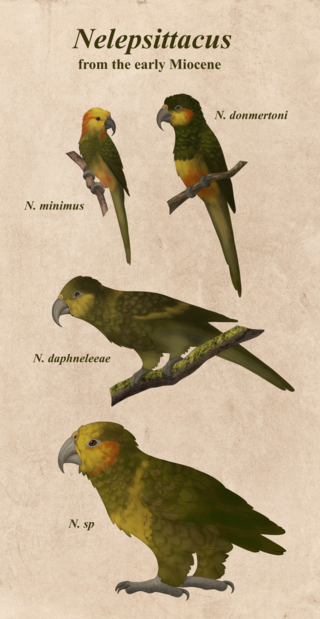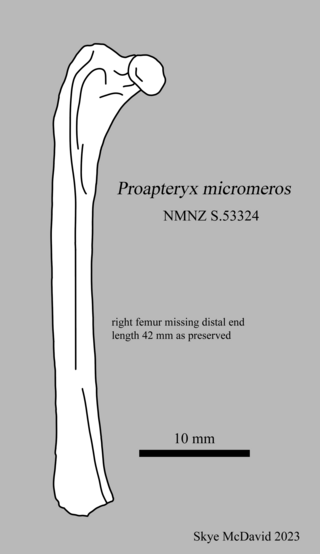
Herons are long-legged, long-necked, freshwater and coastal birds in the family Ardeidae, with 72 recognised species, some of which are referred to as egrets or bitterns rather than herons. Members of the genera Botaurus and Ixobrychus are referred to as bitterns, and, together with the zigzag heron, or zigzag bittern, in the monotypic genus Zebrilus, form a monophyletic group within the Ardeidae. Egrets do not form a biologically distinct group from herons, and tend to be named differently because they are mainly white or have decorative plumes in breeding plumage. Herons, by evolutionary adaptation, have long beaks.

Leiopelma is a genus of New Zealand primitive frogs, belonging to the suborder Archaeobatrachia. It is the only genus in the monotypic family Leiopelmatidae. The leiopelmatids' relatively basal form indicates they have an ancient lineage. While some taxonomists have suggested combining the North American frogs of the genus Ascaphus in the family Ascaphidae with the New Zealand frogs of the genus Leiopelma in the family Leiopelmatidae, the current consensus is that these two groups constitute two separate families. The four extant species of Leiopelmatidae are only found in New Zealand.

St Bathans, formerly named Dunstan Creek, is a former gold and coal mining town in Central Otago, New Zealand. The settlement was a centre of the Otago Gold Rush, but mining has since long ceased. It is now largely a holiday retreat due to the preservation of many of its historic buildings.
The Saint Bathans mammal is a currently unnamed extinct primitive mammal from the Early Miocene of New Zealand. A member of the Saint Bathans fauna, it is notable for being a late-surviving "archaic" mammal species, neither a placental nor a marsupial. It also provides evidence that flightless fully terrestrial mammals did in fact once live in Zealandia. This is in contrast to modern New Zealand, where bats, cetaceans and seals are the only non-introduced mammals in the otherwise bird-dominated faunas.

Prior to human settlement, the mammals of New Zealand consisted entirely of several species of bat and several dozen marine mammal species. Far earlier, during the Miocene, at least one "archaic" terrestrial mammal species is known to have existed, the Saint Bathans mammal. The Māori brought the kurī and kiore in about 1250 CE, and Europeans from 1769 onwards brought the pig, mice, two additional species of rats, weasels, stoats, ferrets and possums and many other species, some of which cause conservation problems for indigenous species.

Nelepsittacus is a genus of extinct New Zealand parrots that is closely related to the genus Nestor. It consists of four species, of which three have been named so far. The species are all known from the early Miocene Saint Bathans Fauna from the Lower Bannockburn Formation in Otago in New Zealand.

Proapteryx micromeros is an extinct kiwi known from the 16–19 million-year-old early Miocene sediments of the St Bathans Fauna of Otago, New Zealand.
Rupephaps taketake, also referred to as the Saint Bathans pigeon, is an extinct species of pigeon from the Miocene of New Zealand. It is the first species of columbid to be described from pre-Pliocene fossil deposits in the Australasian region.

The St Bathans fauna is found in the lower Bannockburn Formation of the Manuherikia Group of Central Otago, in the South Island of New Zealand. It comprises a suite of fossilised prehistoric animals from the late Early Miocene (Altonian) period, with an age range of 19–16 million years ago.
Manuherikia is a genus of extinct species of ducks from the Miocene of New Zealand. It was described from fossil material of the Saint Bathans Fauna, in the lower Bannockburn Formation of the Manuherikia Group, found by the Manuherikia River in the Central Otago region of the South Island. The genus name comes from the name of the geological formation in which the fossils were found and, ultimately, from the Manuherikia River and its valley.
Miotadorna is a genus of extinct tadornine ducks from the Miocene of New Zealand. It contains two species, M. sanctibathansi, and M. catrionae.
Dunstanetta johnstoneorum is a genus and species of extinct duck from the Miocene of New Zealand. It was described from fossil material collected from a Saint Bathans Fauna site on Home Hills Station, in the lower Bannockburn Formation of the Manuherikia Group, in the Manuherikia River valley in the Central Otago region of the South Island. The genus name refers to the Dunstan Range, the mountains of which overlook the fossil site. The specific epithet honours Ann and Euan Johnstone of Home Hills Station.
Matanas enrighti is an extinct duck from the Miocene of New Zealand. It was described from fossil material collected from a Saint Bathans Fauna site near Mata Creek, in the lower Bannockburn Formation of the Manuherikia Group, in the Manuherikia River valley in the Central Otago region of the South Island.

Pikaihao bartlei, also referred to as Bartle's bittern or the Saint Bathans bittern, is a genus and species of prehistoric small bittern from the Early Miocene of New Zealand. It was described in 2013 from fossil material found in the Saint Bathans Fauna of the Bannockburn Formation, at Home Hills Station in the Manuherikia River valley of Otago, South Island. It was a contemporary of the much larger Saint Bathans heron, remains of which have been found in the same sediments. The genus name Pikaihao comes from the Māori pi and kaihao (“fisherman”). The specific epithet honours Sandy Bartle, Curator of Birds at the Museum of New Zealand Te Papa Tongarewa from 1976 to 2009.

The Manuherikia Group is a fluvial-lacustrine sedimentary fill in the Central Otago area of New Zealand, at the site of the prehistoric Lake Manuherikia. The area consists of a valley and ridge topography, with a series of schist-greywacke mountains at roughly ninety degrees to each other. The Manuherika Group occurs in the current basins, and occasionally on the mountains themselves.
Kuiornis indicator is an extinct New Zealand wren (Acanthisittidae) known from the early Miocene St Bathans fauna in Central Otago. It is known from a holotype proximal right tarsometatarsus. Amongst acanthisittids it is most closely related to the living rifleman.

Heracles inexpectatus is a giant fossil parrot species from New Zealand, assigned to a monotypic genus Heracles, that lived during the early Miocene approximately 16 to 19 million years ago. The species was described from two tibiotarsus fossils discovered in 2008 at Saint Bathans, Otago, New Zealand. It is believed that the species stood up to 90 cm tall and weighed approximately 7 kg (15 lb). Initial analysis suggests that this parrot is from the order Psittaciformes and from the superfamily Strigopoidea, which consists of three confirmed primitive genera of parrots: Nestor, Strigops (Kākāpō) and the fossil Nelepsittacus. It may have been the ancestor of the kākāpō.

Zealandornis is an extinct genus of zealandornithid bird from the early Miocene Bannockburn Formation of Otago, New Zealand. The genus contains a single species, Zealandornis relictus, known from a distal right humerus.
Notochen, also called the Bannockburn swan, is an extinct genus of anatid bird from the Early Miocene Bannockburn Formation of Otago, New Zealand. The genus contains a single species, Notochen bannockburnensis, known from various fossil material.

František Bayer was a Czech zoologist, paleontologist and teacher. He taught at secondary schools before becoming director of the Jiráskovo Gymnasium in Prague. In his spare time he worked on the Cretaceous vertebrates of the region. He specialized in the fishes although he also described birds, amphibians and reptiles. The taxonomic affinities of some of the taxa he described have since been redetermined. He also took an interest in music, both composing and writing about music.











